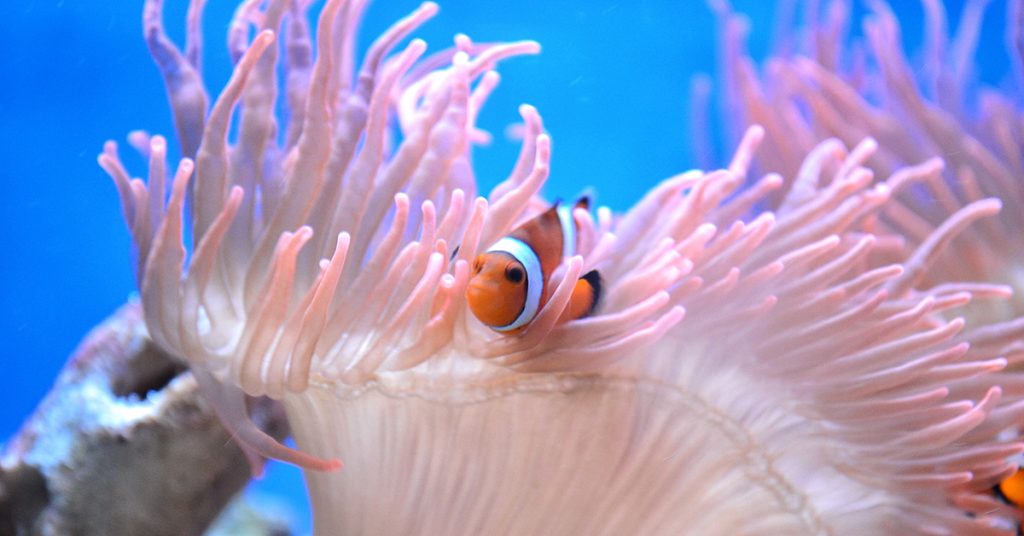Especially popular due to their featuring in the movie “Finding Nemo”, clownfish are one of the most popular marine aquarium pets. Nemo and his dad, Marlin, were what are referred to as “false clownfish” or Percula Clownfish (Amphiprion Percula). Clownfish are so named because of their vibrant color patterns, reminiscent of the face paint of a circus clown. There are 28 species of clownfish which also referred to as anemonefish because of their symbiotic relationship to the sea anemones in which they make their homes and which offer them protection from predators. When small, clowns tend to stay within a short distance of their stinging anemone host. As they get larger, they will travel a greater distance to seek out food but they don’t venture much more than a few yards from the protection and safety of their host anemone.
The Beneficial Anemone
The main reason why clownfish are also called anemone fish, is that they are attracted to anemones is because living within the tentacles of the anemone offers many benefits to the clownfish. The primary benefit is that the anemone provides protection. Sea anemone tentacles are capable of delivering a powerful toxic sting, which can paralyze not only small fish, but larger marine creatures as well. The clownfish are immune to this sting, so if a predator comes too close, the fish can quickly swim into the anemone, hiding within the tentacles. Clownfish are protected from the stinging cells of their host anemone by a coating of protective mucus over their bodies. In reality, clownfish are actually vulnerable and at risk to the anemone’s stinging cells, but the mucus prevents the cells from “firing”. However, whereas some clownfish seems to have developed permanent genetic protection, most species of clownfish have to acclimatize to a new anemone.
During the acclimation process, the clownfish start off by touching its ventral fins and belly area to the stinging tentacles of the anemone and are stung in the process. This behavior continues over a period of several hours until the fish acquires its layer of mucous protection and becomes immune to the anemone’s stings. It then can venture deeper into the anemone and acquire the protection that the deadly waving tentacles of the anemone provide. Whether the protective mucus is produced by the fish itself, or is gathered from the anemone, or both, is unclear, but it works by preventing the anemone from believing the fish poses a threat.
There are approximately 28 species of clownfish and over 1,000 species of anemones worldwide. But not all clownfish can live with the stinging tentacles of the 11 anemones that host fish. In fact, only the yellowtail clownfish, Amphiprion clarkii, is believed to be able to naturally enjoy a host relationship with all hosting anemones. Some species of clownfish are only found to be hosted in the wild with one anemone species.
Juvenile clownfish are able to locate an anemone by using chemical recognition of particular host anemone species. When clownfish mate, they lay their eggs in close proximity to their host anemone and appears that during this developmental stage, the embryonic fish may be chemically imprinted with “cues” from the host anemone of the parents. Thus, when they select an anemone in later life, they choose the same species that their parents occupied.
It is not only the clownfish that benefit from this symbiotic relationship. The host anemones also derives benefits from the fish. Clownfish aggressively defend the anemone from other small fish that may want to feed upon it. Some marine experts also believe that the unique movements of clownfish help to aerate the water near the anemone, increasing its respiration. In addition, these fish help to pick away parasites that cling to the anemone.
Popularity of Clownfish
Clownfish are easily the single most popular fish in the home marine aquarium trade due to their “movie star” status and their low cost. Clownfish have been successfully bred in captivity since 1972 and can now be bred by even an average hobbyist. This not only makes them inexpensive, but also relieves the pressure to capture them from the natural reefs. Clownfish have also taken on a “designer” status and cross-breeding has resulted in some rather spectacular color combinations and patterns which as make such unique fish in high demand and a bit more costly. While a standard False Percula can often be acquired for under $10, some of the designer clowns can garner a $100 per fish or even more. Clowns are also very hearty and can survive in marine aquariums with water conditions that can be described as less than optimum. Unfortunately, that cannot be said for their host anemones.
Keeping Anemones
While most might think an anemone is a plant, that is not the case. Sea anemones are cnidarians, closely related to jellies and corals. Most anemones are sessile with a specialized foot used to anchor them in soft substrates or attach themselves to rocks. To keep anemones happy, aquarists need to provide excellent water conditions, moderate to strong current, and intense lighting. Bits of shrimp or other meaty foods can be used to supplement their diet. In fact of the benefits of hosting clowns is that the anemone will benefit from the occasional bit of food dropped by the clownfish. The digestive system of anemones requires a specific type of algae and although the anemone, since it is not a plant, cannot live by photosynthesis, the algae that permits the anemone to digest its food requires it. In short, if your aquarium does not offer the right lighting, your anemone will shrink and eventually starve to death.
